Underworld: Ascendant review - a strangely essential development disaster
Ultimaddening.
Underworld: Ascendant is positively paranoid that you'll forget that it's an immersive sim. A crowd-funded successor to Looking Glass Studios' landmark RPG Ultima Underworld, created with the input of Looking Glass veterans, its dialogue is full of allusions to the genre's ethos of player improvisation using flexible tools. “Experimentation is advised,” remarks Cabirus, the papier-mâché beard in a dressing gown who serves as your mentor on the quest to defeat Typhon, an escaped demon king. Later: “only the adaptable prosper”. Elsewhere: “I seek not to teach you, but to make you think.”
The game's relentless advertising of its own creative inheritance soon grows annoying, and not just because in practice, it's more interested in channeling Ultima's light-fingered stablemate Thief. Looking Glass closed down almost 20 years ago, and its legacy is everywhere, reaching far beyond self-declared immersive sims to any number of shooters, open worlders and more linear RPGs. To preach the importance of methods over results in the wake of, say, Hitman: Blood Money or Heat Signature feels like your dad expecting a round of applause for explaining the plot of The Matrix. In any case, Ascendant's immersive sim premise doesn't really flatter it, because it means that you're actively looking for breakages and limitations you can take advantage of, and there are ever so many of them to find. It's certainly a game about experimentation in the sense that a lot of it doesn't work.
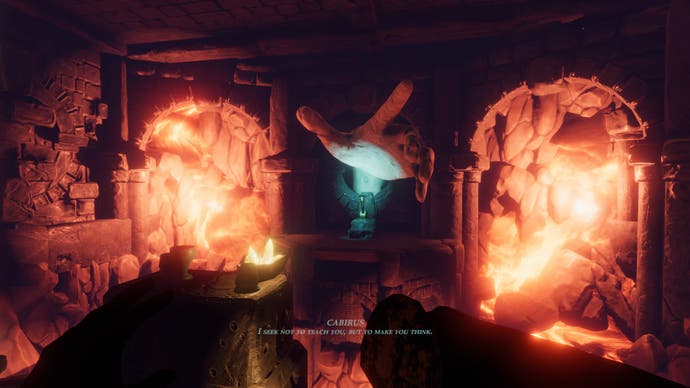
The game's current bug list is so grand, varied and hideous it deserves to be bound in crocodile skin and hidden away in a mausoleum, as a kind of Necronomicon for QA testers. There are crumbling citadels that are invisible from certain angles, and lakes with two surfaces, one glimmering metres below the other. There are blade traps that don't just stop moving but vanish when you pull a lever, though you can still hear them rattling away. Rooftops that turn to vapour underfoot, trapping you inside a backdrop, and dangling chains that bunch as you climb like constipated snakes. Enemies who literally couldn't beat a flight of stairs, and flights of stairs that have been so hastily cobbled together you can see the gaps between sections. It's not, all told, a game you should play if the slightest glitching texture sends you screaming for your pitchfork, and while Ascendant does manage a few unusual ideas within the handworn parameters of a dark fantasy role-player, most are as wayward as their execution is tortuous.
For all this, there is something fascinating about the game - a correspondence between its dysfunctional simulation and the genre it rather presumptuously lays claim to which holds the gaze like an unholy planetary alignment. It's not just that it's hard to look away from an open wound: there's an underlying point here about the genre's mix of appreciation for and antagonism towards the agency of the player. I'll come back to all that, though - first, let's talk quest rewards and mystic lizards.
To nobble Typhon you must recover seven Abyssal keys from around the Underworld to open a big metal door, in the course of a few dozen main and sidequests accessed via a dimensional portal from an admittedly rather pretty hub city. Annoyingly, you can only tackle one mission at once, even when they're set in the same region, and even when the other mission is something as trite as finding an armour piece. If the idea is to foster intimacy with the levels through repetition, Ascendant's branching cavern layouts are seldom worth another visit, not least thanks to its refusal to let you save progress within them. You can checkpoint at preset intervals by sowing the seed of a magic sapling, but all of that's lost when you quit.
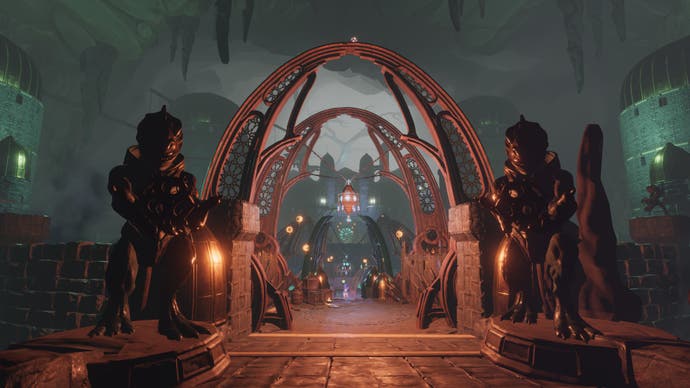
Sidequests are undertaken on behalf of three factions, whose requests are conveyed by the Saurians, a race of mediators who are (I suspect) permitted to exist in-game because they don't have lips, and so don't require complex facial animations. Raising your favour with these factions unlocks rarer store items and special missions, though I wasn't able to dig into the possibilities before the barrage of bugs brought my playthrough to a halt. Each of the factions prefer certain tactics and so, pressures you to go about your Stygian business a certain way. It's an engaging touch, one of many fighting for oxygen amid Ascendant's problems.
Another is the level-up system, which sees you earning points for new abilities (spread across stealth, melee and spell-casting unlock trees) not just by killing things but by performing specific feats, such as combining spells with melee combat. In theory, this more elusive approach suits the focus on improvisation, but many of the "feats" are tame, and you'll stumble on a lot of them at random. Literally stumbled, that is - I scored the "long jump" feat by falling off a cliff and landing outside the level's navigable parameters, rock textures drifting like shark fins across a blue-white void.
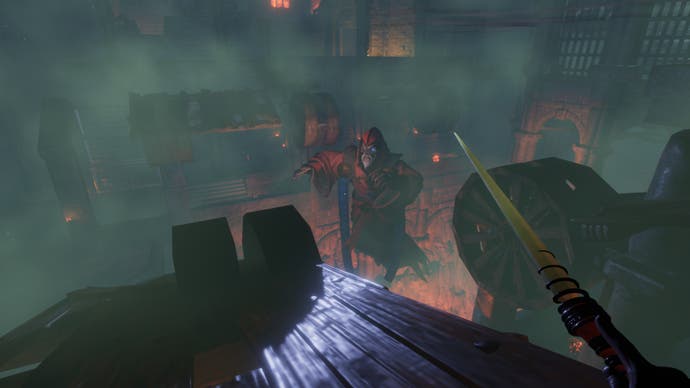
In terms of how it all handles, think Dishonored if Dishonored's lead character was a helium-filled octopus. Jumping is fiddly and weightless, but you can hold the button to ooze back onto surfaces after glancing off them. Melee combat is a question of charging a heavy attack, running in and bouncing back to avoid the riposte: there are special moves to unlock, but the game is reluctant to tell you how they're performed, and I largely forgot I'd acquired them. The limits of your avatar's body are hard to pin down, which is vexing when hopping around to gather the mana wisps that are your chief means of powering spells. The stealth system, at least, just about makes sense - as in Thief, you'll douse torches with water arrows to mask your approach, but sometimes the arrows don't work, and in any case, the AI is easily bamboozled when alerted. At one point I managed to give a walking skeleton the slip by jumping onto his head.
In general, Ascendant's creatures are more deserving of pity than rage. Skeleton soldiers have keen ears but are thwarted by any terrain fixture more complex than a doorway: you'll find them standing sadly behind barrels or in crevices, awaiting the blessed relief of an axe to the neckbone. Human assassins fare better, teleporting away in a cloud of smoke when trapped or ambushed; they're so good at this, in fact, that they often forget to do any assassinating. Spirits are invulnerable till you blow up the sinister totempole that tethers them to this plane, but also spend a lot of time near the cave roof where they can't see you anyway. If weapons are scarce (they deteriorate with use), crates are your best friends. Hold one up and you can hide behind it, the AI being entirely unbothered by the sight of a floating box. Enemies also don't perceive damage from burning objects as an act of aggression, and sometimes don't even trouble to avoid it. I have vanquished many a foe by setting a basket on fire and pressing it gently against the creature's leg.
Factor in the outright bugs, and you've got a catastrophe that keeps on giving, each moment of exasperation or incredulity paling before the next. At one point I got stuck in a flooded passage because the momentum from a dive carried me through a gap that shouldn't have been accessible; fortunately, I was able to reset to the checkpoint (you can't do this manually) by casting a spell to poison myself. Later I tried to jump off a chain and it wouldn't let go, leaving me to thrash about like a fish while skeletons yelled impotently from distant corners.
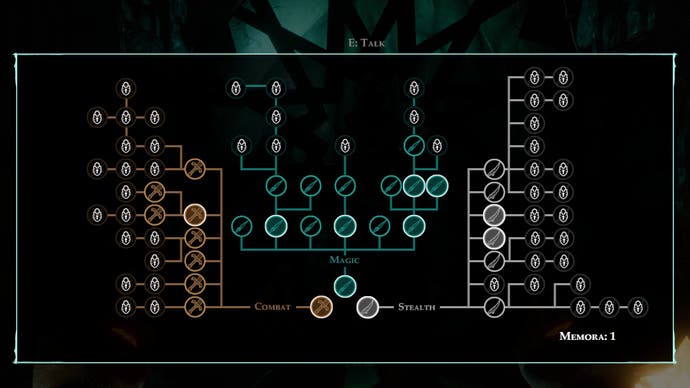
I was ready to call it a day, but even at its worst, Ascendant can be oddly hard to put down. The more straightforward explanation there is that, given another year in the oven and enough bughunting to sterilise the surface of LV 426, this could be an enjoyable sim. Even an interesting one. The core of the game may be mouldy but there are those occasional glimmers of intrigue. Take the Deep Slugs. They're flexible tactical props, leaving a trail of flammable gloop behind them. You can lure one over - right through an enemy position, say - by chucking it a piece of fruit. You can also feed them different things to change what they exude. A cloud of oily darkness, for instance. I can't say I've ever been fascinated by mollusc digestion, but that was before I knew I could use their farts as a smokescreen.
The game's propagating fire system is also rather exciting, once you get beyond the basic tactic of burning down locked doors. Conflagrations spread fast, which is a big deal in a world where much of the architecture is wooden: at one point, an ill-advised fireball started a maelstrom which consumed the fort I'd been sneaking through, reducing an entire set of routes and obstacles to bare rock and a few smouldering struts. And then there's magic, which sees you jumbling together runestones in your hands to spell out ethereal bullets, force shields and the like. You're not told what each combination does, so it's up to you to make deductions based on each rune's definitions and label the results. A lot of combinations are off-limits, but I found the illusion of "programming" my own spells attractive nonetheless.
Given another year in production, ideas like that might eclipse the ragged edges. But then again, perhaps there's something to the notion of an immersive sim that's palpably unfinished. One of the genre's recurring conceits is the idea of the designer as the player's ultimate antagonist, checking your movements while proposing to free you of constraint. All games can be read in these terms, of course, but immersive sims make a principle of it: they are games that define defeat not merely as failing a task or dying, but as doing what you're supposed to, following the cues. Many of them give the unbridled exercise of the player's will a decided political inflexion: Thief's cynicism about its own society, for instance, is right there in the title.
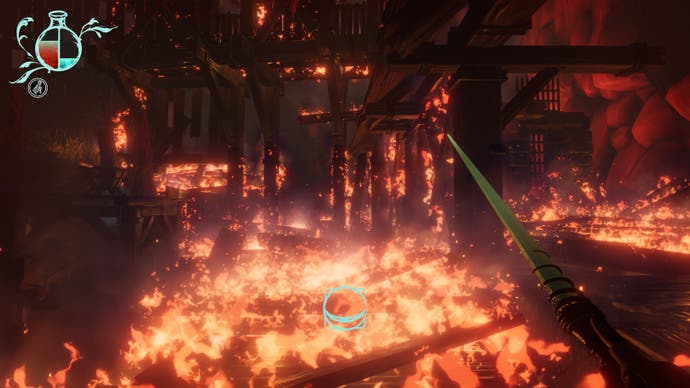
The trouble is, while immersive sim developers want you to do things with their tools they haven't planned for, the majority also want their worlds to be consistent, plausible, bendable but not actually breakable. This contradiction infests the Dishonored games, especially, which host some of gaming's richest and most storied urban settings, squalid places where you can feel the rot dripping from every gable, while all but telling you throughout that every street corner is a mechanistic fiction toyed with by a capricious god. These games want you to take their tales of greed, disease and vengeance seriously, casting the player as witness and judge, but they also want you to see their worlds as the Outsider would - as a videogame designer would - a lazy spiral of props and textures, floating in void. It's this irresolution, explored in fretful structural metaphors like Dishonored 2's Clockwork Mansion, that for me gives Arkane's work its power.
Perhaps the only "successful" immersive sim, then, is the one you can genuinely break. About an hour into my time with Underworld: Ascendant, I made a calculated hop onto a boulder and fell through into the very last level. I'd read that such a glitch existed, but I found the point of entry all by myself, and it's probably the most "meaningful" choice I've made in the Underworld. There I was with nothing but an Argos-brand wand and a bone club to my name, facing the Big Bad in a hellish cathedral surrounded by lavafalls. I couldn't complete the level without all seven keys, and struggled to make headway against its menagerie of spellcasters and spooks. But still - wasn't I, in fact, playing the game as its developers would like? Preying on the gaps in the stage machinery, osmosing through its facade? It wasn't much fun, either way, but in all my time with Ascendant, I have never felt more immersed.



